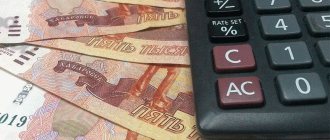As it was before
In the recent past, officials had a unequivocal opinion - it is prohibited to divide the VAT deduction for one invoice into different periods. Such conclusions can be found, for example, in letters of the Ministry of Finance dated December 9, 2010 No. 03-07-11/483, dated October 13, 2010 No. 03-07-11/408 and others. At the same time, the department’s specialists referred to the fact that such a procedure is not provided for by tax legislation. Indeed, Articles 171 and 172 of the Tax Code, devoted to deductions, did not contain rules directly allowing for the “scattering” of VAT deductions.
However, the majority of arbitration courts reasoned differently: firstly, the legislation does not directly prohibit deductions for partial applications, and, secondly, this does not lead to non-payment of tax. Therefore, the arbitrators in most cases recognized the splitting of the VAT deduction as legal. Similar conclusions are given, for example, in the Resolution of the Federal Antimonopoly Service of the Moscow Region dated February 12, 2013 No. F05-15985/12, as well as in many others.
How to issue a consolidated invoice in 2021
When and how a consolidated invoice combines transactions and payments, consider the options.
One invoice for several contracts
In financial and economic activities, enterprises use contracts to regulate the conditions between the parties to the transaction. Agreements are concluded both for individual transactions and for long-term cooperation, the stages of which are recorded by several separate primary documents confirming the shipment of goods or the provision of services at each stage.
If an enterprise has entered into two contracts with the same counterparty, is it possible to issue one invoice for both contracts? Yes, if, for example, the same counterparty delivers the goods at the same time or no later than 5 days according to the calendar. The consolidated invoice indicates the combined number of units of goods supplied under contracts or services provided under the terms of contracts. The date of the consolidated invoice in this case will be the date the parties signed the first primary documents.
Consolidated invoice for heterogeneous transactions
It happens that under an agreement or several agreements, the seller of goods and the performer of the service provided to the buyer, for example, delivery of products or installation of equipment, are one legal entity. In this case, the seller has the right to issue a consolidated invoice for the shipment of goods, services provided and work performed. When filling out a consolidated invoice, the seller indicates the product and service in one consolidated invoice on different lines, combining their costs into one total amount.
Advance invoice for several payments under one contract per day
Some buyers make an advance payment under contracts to the seller's bank account by transferring funds for goods or services in several payment orders per day. That is, if you have two payments on one day, you can make one advance invoice. In this case, when issuing a consolidated invoice for advances, the seller indicates in it the consolidated amount of advances deposited into the seller's current account, listing the numbers of payment orders separated by commas in the highlighted line of the consolidated invoice. An important condition for issuing a consolidated invoice in this case is a five-day period combining transfers. The Tax Code does not prohibit such an operation; tax authorities also do not object, provided that when issuing a consolidated invoice, the procedures and rules provided for by law are followed.
What changed
This contradiction between the positions of the Ministry of Finance and the courts persisted until January 1, 2015. But to the delight of taxpayers, the situation has changed - on the specified date, amendments to the Tax Code came into force. One of them concerned Article 172, which was supplemented by paragraph 1.1 . According to the norm contained therein, it is now possible to claim VAT deductions in any tax period within three years from the date of acceptance of goods for accounting . This gives companies the opportunity to manage the amount of deductions and claim them in the period when they consider it necessary.
In what cases is this convenient? For example, if the taxpayer wants to avoid indicating the amount of VAT to be refunded in the declaration. After all, in doing so, he may be faced with a full-fledged desk audit, within the framework of which the tax service has the right to demand all documents to justify the deduction. And many accountants, in order to avoid this, will prefer to declare the deduction partially, transferring the rest of it to later periods.
Why do you need a deduction transfer?
The right to transfer deductions to other periods has been assigned to the taxpayer since 2015. In Art. 172-1.1 of the Tax Code of the Russian Federation states that deductions can be claimed within a three-year period after purchase in any tax period.
The main reasons for transferring deductions that the company follows are:
- possible claims from the Federal Tax Service;
- desire to leave the amount of deductions “in reserve”;
- “late” invoices.
Accountants are faced with the first scenario if a company purchases an expensive product and sales in the reporting quarter are low. Having analyzed the declaration, which shows a large amount to be reimbursed from the budget, the Federal Tax Service may suspect a fraudulent scheme. Typically, in such a situation, officials request documents confirming a large deduction as part of an audit assigned to the organization, demand a written explanation of where it came from, and clarify the details of the transaction. There may be an inspection of the counterparty, or even a call to the head of the organization to give clarification in person at the tax office (“VAT tax commission”).
On a note! Tax officials can call a representative of a company to a commission on the basis of Art. 19.4-1 Code of Administrative Offenses of the Russian Federation. Failure to appear threatens the director with a fine of up to 4 thousand rubles.
Experienced accountants also know about such an indicator as the “safe percentage of deductions” for taxes. It is reflected in the Order of the Federal Tax Service No. MM-3-06/333 dated 05/30/07 (Appendix 2) and amounts to 89% of deductions for the previous calendar year, i.e. if at the end of the year the share of deductions is equal to or higher than this indicator, it is considered significant. The company is included in the tax audit plan as a potential violator of tax laws.
To avoid this kind of problem, tax deductions are “distributed” across periods and their amounts are regulated.
Many companies seek to defer deductions, guided by the specifics of their activities: significant purchases of goods, raw materials, etc. occur in one tax period, and a high level of sales in another. The “surplus” VAT is carried forward to another period and thus avoids the prospect of paying high VAT.
There are often cases when the invoice confirming the deduction reaches the accounting department late. Then the deduction amount is transferred to another quarter.
Important! Invoices for the period received after its end, but before the submission of the VAT return (25th day of the next month), can be included in the calculations for this period (Article 172-1.1, paragraph 2). The letter of the Ministry of Finance No. 03 07 11/9305 dated 02/14/19 states that if services were performed within the 3rd quarter, and the invoice for them was issued on October 5, the document can be included in the calculation for the third quarter.
Example. The OSNO organization purchased equipment and raw materials to produce a new line of branded products in the first quarter. Economic calculations show that large volumes of sales of goods, and therefore significant amounts of output VAT, should be expected in the 3rd and 4th quarters of the same year. A decision is made to transfer the resulting VAT deduction for the purchase of equipment and raw materials to the 3rd and 4th quarter. The amount will be used to reduce VAT during the specified period.
New position of the financial department
The Tax Code still does not contain a direct rule allowing the deduction to be applied in parts - it only clearly allows it to be declared in tax periods within three years after the goods are accepted for accounting. However, now that flexible options for managing the deduction have appeared, the ban on its fragmentation loses all meaning . The position of Ministry of Finance officials has changed, which is reflected in letters No. 03-07-11/20290 and No. 03-07-11/20293 dated April 9, 2015. They conclude that splitting the VAT deduction for one invoice into several tax periods generally does not contradict the Tax Code.
The exception is transactions for the acquisition of fixed assets, equipment for installation and intangible assets - on the basis of paragraph 1 of Article 172 of the Tax Code of the Russian Federation, VAT on them is deducted in full after the said assets are accepted for accounting. In addition, splitting the deduction into several periods is unacceptable for VAT paid as a tax agent, as well as calculated from payment, prepayment and certain other transactions.
VAT deduction: application features
22 Altai Territory Date of publication: 02/29/2016
Edition: “My Tax Advisor”, No. 2, February 2016 Topic: Value added tax Source: https://www.uic22.ru/content/blogcategory/22/55/
Features of application VAT deduction: transfer of VAT deduction on goods (works, services), fixed assets, determination of a three-year period when transferring VAT deduction, application of VAT deduction on an invoice received late
VAT deduction in parts in different tax periods
The taxpayer has the right to reduce the total amount of VAT calculated in accordance with Art. 166 of the Tax Code of the Russian Federation (hereinafter referred to as the Code), for tax deductions (clause 1 of Article 171 of the Code). The deduction includes, among other things, VAT amounts presented to the taxpayer when purchasing goods (work, services) for carrying out transactions recognized as objects of VAT taxation, or for resale (clause 2 of Article 171 of the Code).
Deduction of VAT amounts is carried out on the basis, in particular, of invoices issued by sellers of goods (work, services) after the registration of these goods (work, services) and in the presence of relevant primary documents (clause 1 of Article 172 of the Code).
In accordance with the newly introduced clause 1.1 of Art. on January 1, 2015. 172 of the Code, the specified tax deductions can be claimed in tax periods within three years after the registration of goods (work, services) purchased by the taxpayer on the territory of the Russian Federation or goods imported by him into the territory of the Russian Federation. Thus, the deduction of value added tax on the basis of one invoice in parts in different tax periods within three years after registration of goods (work, services), with the exception of fixed assets, equipment for installation and (or) intangible assets , does not contradict the norms of the Code. This position is explained by the norms of paragraph. 3 p. 1 art. 172 of the Code, according to which deductions of tax amounts presented by sellers to the taxpayer upon acquisition or paid upon import into the territory of the Russian Federation and other territories under its jurisdiction of fixed assets, equipment for installation and (or) intangible assets specified in paragraphs 2 and 4 Article 171 of the Code are carried out in full after registration of data on fixed assets, equipment for installation and (or) intangible assets (letter of the Ministry of Finance of the Russian Federation dated May 18, 2015 No. 03-07-R3/28263). The amount of “input” VAT on fixed assets, intangible assets and equipment for installation cannot be claimed for deduction in different tax periods in parts. In accordance with clause 1.1 of Art. 172 of the Code, a taxpayer can declare this amount of VAT for deduction in any quarter within three years from the date of registration of the relevant object. Established in clause 1.1 of Art. 172 of the Code, the rule giving the right to take advantage of a deduction in any quarter for three years does not apply to all tax deductions, but only to those provided for in paragraph 2 of Art. 171 of the Code. This applies, for example, to VAT: a) calculated by the seller on advances received for future deliveries of goods, performance of work, provision of services, transfer of property rights (clause 8 of Article 171 of the Code); b) presented to the buyer when he transfers advances against upcoming deliveries of goods, performance of work, provision of services, transfer of property rights (clause 12 of Article 171 of the Code); c) paid by buyers - tax agents, which are specified in clause 3 of Art. 171 Code; d) calculated according to construction and installation works for own consumption (clause 5 of Article 172 of the Code); d) presented for travel expenses. In this regard, such deductions should be made in the tax period in which the taxpayer has met the appropriate conditions provided for in Art. Art. 171 and 172 of the Code (letter of the Ministry of Finance of the Russian Federation dated 04/09/2015 No. 03-07-11/20290, letter of the Ministry of Finance of the Russian Federation dated 07/21/2015 No. 03-07-11/41908). When claiming a deduction in parts for one invoice, questions may arise regarding filling out the purchase book, namely column 15 “Cost of purchases on the invoice” and 16 “VAT amount on the invoice accepted for deduction.” It should be noted that in this case the invoice will have to be registered several times. In column 16, each time you need to indicate only that part of the amount of “input” VAT that is claimed for deduction in the current quarter. As for column 15, it should reflect the entire cost, which is indicated in column 9 on the “Total payable” line of the corresponding invoice. The requirement for filling out column 15 is established by the Rules for maintaining a purchase book (approved by Decree of the Government of the Russian Federation of December 26, 2011 No. 1137).
Deduction of VAT on invoices received late
A prerequisite for deducting input VAT is the presence of a correctly executed invoice from the seller. This means that, in general, the deduction of “input” VAT on goods (work, services) accepted for accounting can be claimed by the taxpayer only after receiving the corresponding invoice from the seller. According to the provisions of paragraph 1 of Art. 171 of the Code, VAT payers have the right to reduce the total amount of tax calculated in accordance with Art. 166 of the Code, for tax deductions established by this article. At the same time, paragraph 1 of Art. 172 of the Code provides that such deductions are made on the basis of invoices issued by sellers when the taxpayer purchases goods (work, services), property rights, documents confirming the actual payment of tax amounts when importing goods into the customs territory of the Russian Federation, documents confirming payment of tax amounts , withheld by tax agents, or on the basis of other documents in the cases provided for in paragraphs 3, 6-8 of Art. 171 of the Code. Thus, the taxpayer’s right to deduct “input” VAT arises when the following conditions are simultaneously met: - goods (work, services) were purchased to carry out transactions subject to VAT; — these goods (works, services) are registered on the basis of the relevant primary documents; — a properly executed invoice from the seller is available. At the same time, in practice it often happens that goods are registered in one tax period (quarter), and the invoice is received from the seller in another. In such a situation, obviously, from the literal interpretation of these rules it follows that the deduction can be claimed only in the period when the invoice is received. Meanwhile, as the Ministry of Finance of Russia indicated in letter No. 03-07-11/59682 dated October 19, 2015, there is an exception to this rule. In accordance with clause 1.1 of Art. 172 of the Code, the period for accepting VAT for deduction in the situation under consideration depends on exactly when the “late” invoice was received - before or after the expiration of the period allotted for submitting a declaration for this period. Let us recall that Art. 174 of the Code requires reporting VAT no later than the 25th day of the month following the reporting quarter. In practice, taxpayers upon receipt of “late” invoices may encounter the following situations: - the invoice was received before the 25th day of the month following the quarter in which the relevant goods (work, services) were registered, and the declaration for this period has not yet been presented. In this case, the taxpayer should register the “late” invoice in the purchase book for the quarter in which the goods were registered, in accordance with the general procedure. And, accordingly, in the VAT return for a given period, you can declare the “input” tax on these goods (works, services) for deduction. - the invoice was received before the 25th day of the month following the quarter in which the relevant goods (work, services) were accepted for registration, but the declaration for this period had already been submitted. In such circumstances, the invoice should be registered in an additional sheet to the purchase book for the period in which the goods were registered, and the taxpayer should submit an updated VAT return to the tax authority for this period. - the invoice was received after the 25th day of the month following the quarter in which the corresponding goods (work, services) were registered. In this case, the deduction can be claimed no earlier than the period in which the invoice was received. In conclusion, it should be noted that the new norm of paragraph 1.1 of Art. 172 of the Code is more relevant for taxpayers who receive invoices electronically, since in this case the date of actual receipt of the invoice is clearly determined by the electronic document management system.
What does this look like in practice?
What is the procedure for an accountant if it is necessary to declare a VAT deduction in parts in different periods? Let's look at an example.
In the second quarter of 2015, Ajax LLC purchased a passenger car from Avtotrade LLC at a price of 944,000 rubles, including VAT of 144,000 rubles. The purpose of buying a car is further resale. The buyer's accountant decided to claim VAT deduction in equal installments until the end of the current year. Thus, a deduction in the amount of 48,000 rubles (1/3 of 144,000) will be declared in the II, III and IV quarters of 2015.
At the time of purchase, that is, in the second quarter of 2015, the following transactions are made:
| Wiring | Amount (RUB) | Operation description |
| Dt 08 Kt 60 | 800000 | car price excluding VAT |
| Dt 19 Kt 60 | 144000 | VAT amount |
| Dt 68 Kt 19 | 48000 | first part of VAT deduction |
In the same period, an invoice from Autotrade LLC in the amount of 48,000 rubles is registered in the Purchase Book of Ajax LLC.
In the following quarters of 2015, the accountant must repeat the last entry:
| Quarter 2015 | Wiring | Amount (RUB) | Operation description |
| III | Dt 68 Kt 19 | 48000 | second part of the VAT deduction |
| IV | Dt 68 Kt 19 | 48000 | third part of VAT deduction |
In each of these periods, you should also register an invoice from Autotrade LLC in the amount of 48,000 rubles. Thus, the invoice will appear in the Purchase Book not once indicating the full amount of VAT of 144,000 rubles, but three times for 48,000 rubles.
You can enter the second and third parts of the tax into the Purchase Book on any day of the corresponding period. For example, it is quite convenient to do this on the first day of the quarter.
By the same principle, the accountant of Ajax LLC could “split” the VAT deduction not into equal parts, but into arbitrary parts and into any number of periods within a three-year period from the moment the car was registered. Accepting the deduction in parts with “jumping” over one or more quarters also does not contradict the Tax Code. For example, if for some reason Ajax LLC had no sales operations in the fourth quarter of 2015, then it would be logical for the accountant to transfer the last part of the deduction to the first or any other quarter of 2016.
So, let’s summarize the main points of splitting the VAT deduction:
- You can claim part of the deduction in any quarter, the main thing is that the entire amount is “spent” within three years from the moment the goods are registered;
- the declared part of the deduction must correspond to an entry in the Purchase Book made in the same quarter and for the same amount;
- one invoice will be recorded in the Purchase Book several times in different quarters for an amount corresponding to the declared part of the deduction;
- when adding the partial deduction amounts, the VAT amount indicated on the invoice should be obtained.
Deduction of VAT in parts and reconciliation of the Federal Tax Service
As you know, since the beginning of this year, the tax service has been carefully monitoring all VAT payers, processing their electronic reports automatically. At the same time, information from the books of purchases and sales of counterparties is compared, which have now become part of the expanded tax return. For each transaction, the data specified by the seller and the buyer are compared, including the amount of VAT.
However, if the buyer decides to “split” the deduction into several periods, then VAT will be partially reflected in his Purchase Book, which will not correspond to the entry in the supplier’s Sales Book. When conducting a cross-reconciliation at the end of the quarter, the tax office will identify this discrepancy and may require an explanation. Moreover, based on clause 8.1 of Article 88 of the Tax Code of the Russian Federation, the inspectorate will be able to demand the presentation of an invoice and other documents regarding the transaction, because formally the amount of tax in the buyer’s declaration will be underestimated. As a result, some accountants still prefer not to split deductions due to reluctance to communicate with the Federal Tax Service or fear of sanctions.
But according to many experts, it is completely safe to deduct VAT in parts. Of course, there is a risk of receiving a request from the inspectorate to provide explanations. But since by declaring a partial deduction, the buyer does not violate tax laws, he will be able to explain his actions, submit the necessary documents and without any problems “justify” the incomplete amount of VAT.







